Wooden Bench With Storage
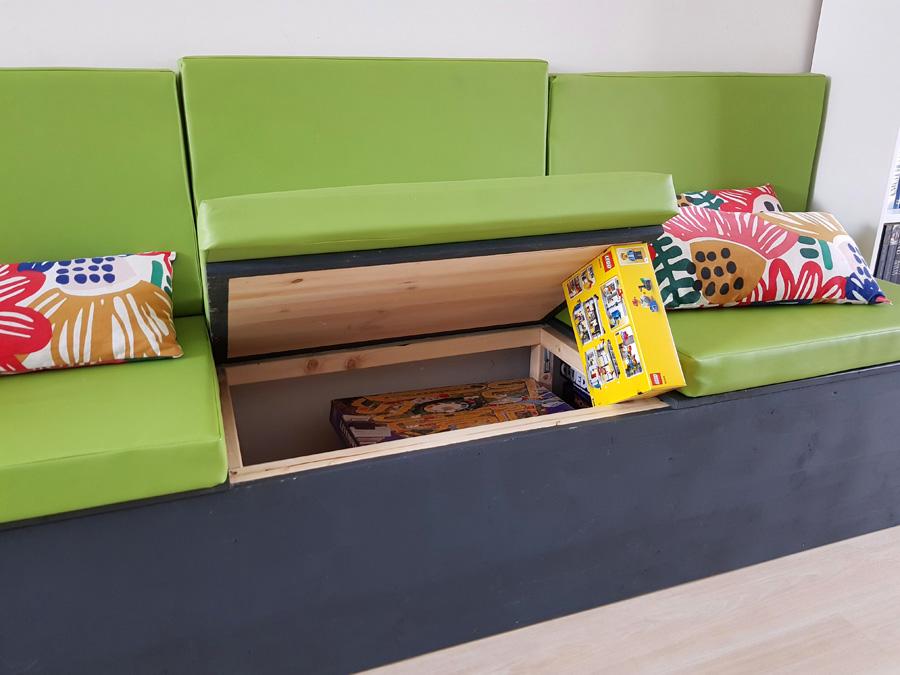
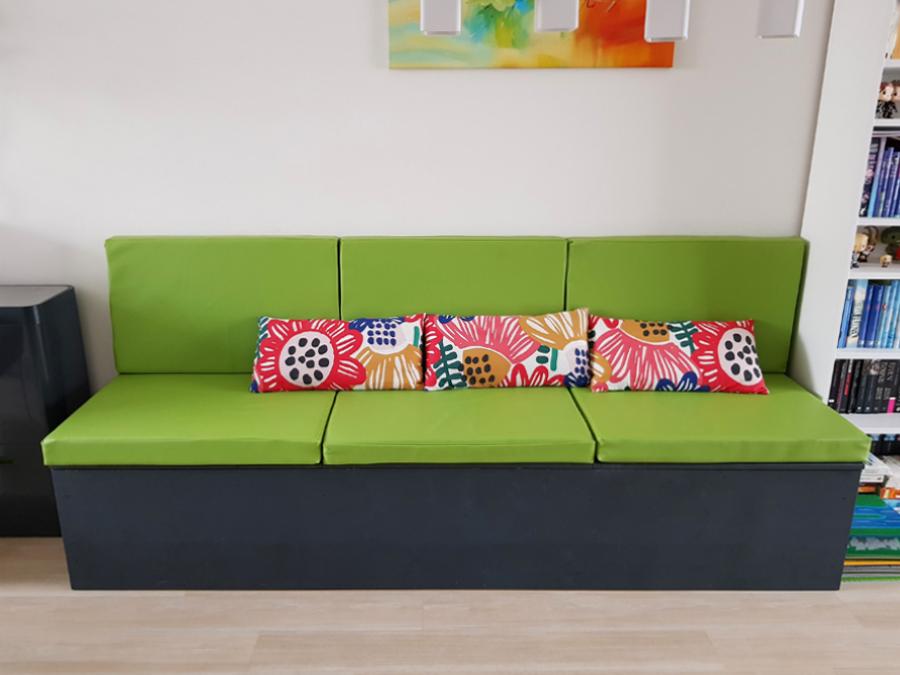
This bench offers a few extra seats at the dinner table and comes with a lot of -invisible- storage space. Perfect for arts & crafts supplies, board games or extra pillows and blankets. The best thing is that you can make this bench in a day (or two if you want to paint it). Just follow this guide and you'll be sitting on your own bench in no time!
Downloads
Supplies
Tools
- jigsaw or miter saw
- drill
- wood drill bit 2mm
- screwdriver
- pencil
- tape measure
- sanding paper
- masking tape (or other removable tape)
Hardware
- 32 wood screws 4x80mm
- 36 wood screws 3,5x40mm (minimum, recommend buying extra)
- 48 wood screws 3,5x20mm (based on 6 screws per hinge)
- 6 hinges (2 for each lid)
- 6 steel corner brackets 100x70x30mm (or similar)
Wood (see shopping list for dimensions and amount)
- wooden beams 44x44mm
- wooden carpentry panels, thickness 18mm
Optional supplies
- wood filler or putty
- paint or lacquer
- paintbrush
- paper or sheet to protect the floor while painting
- felt pads (floor protection)
Preparation
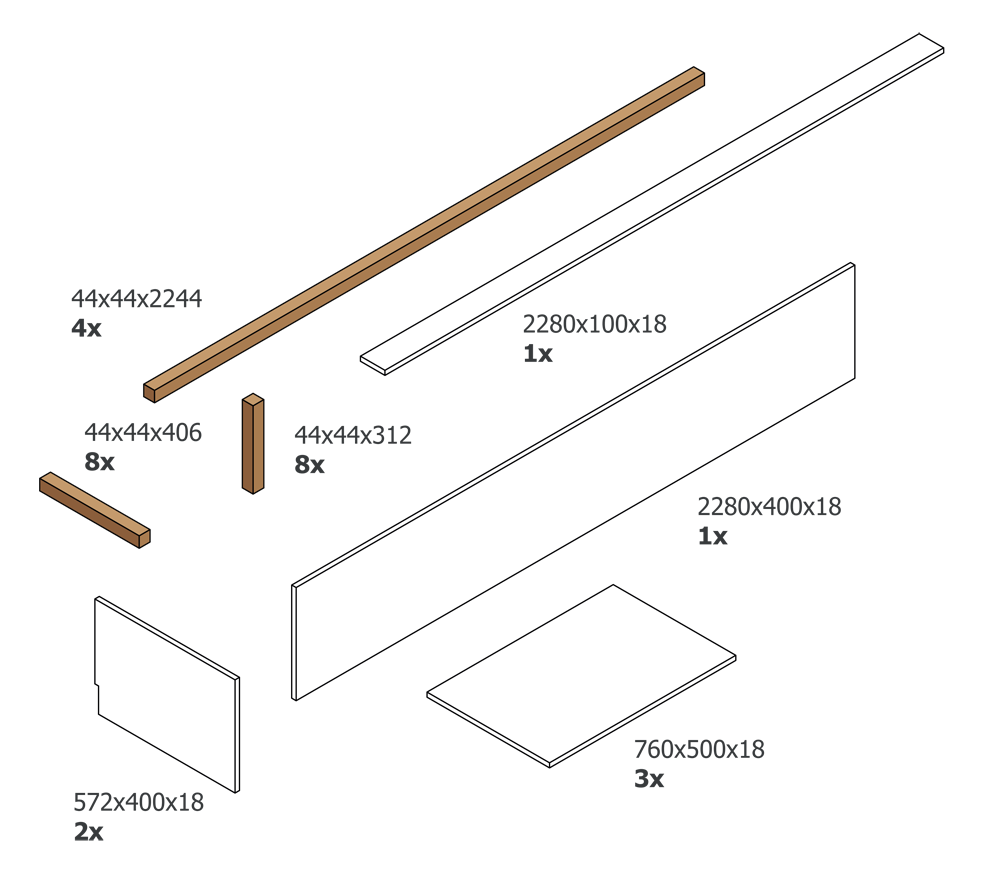
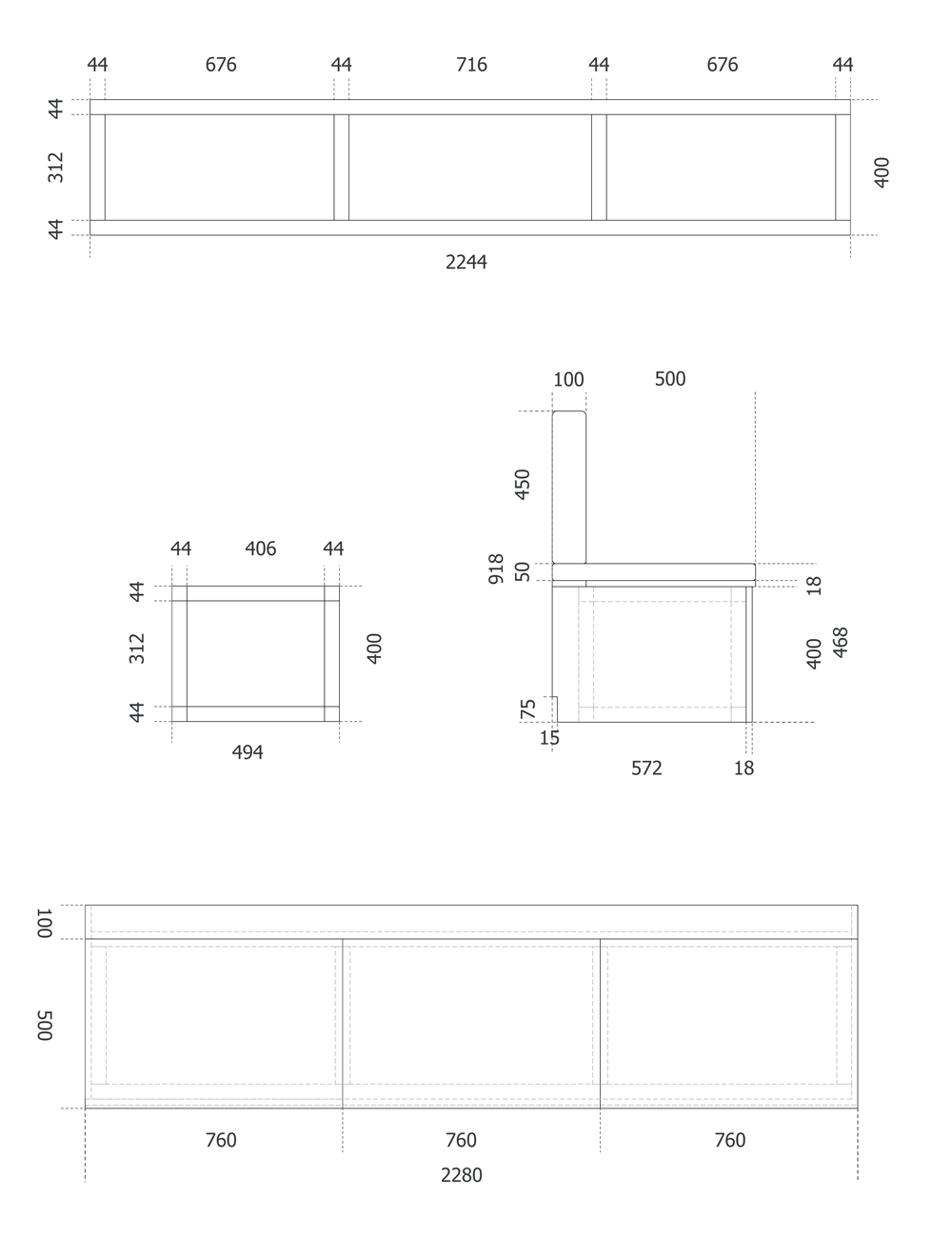
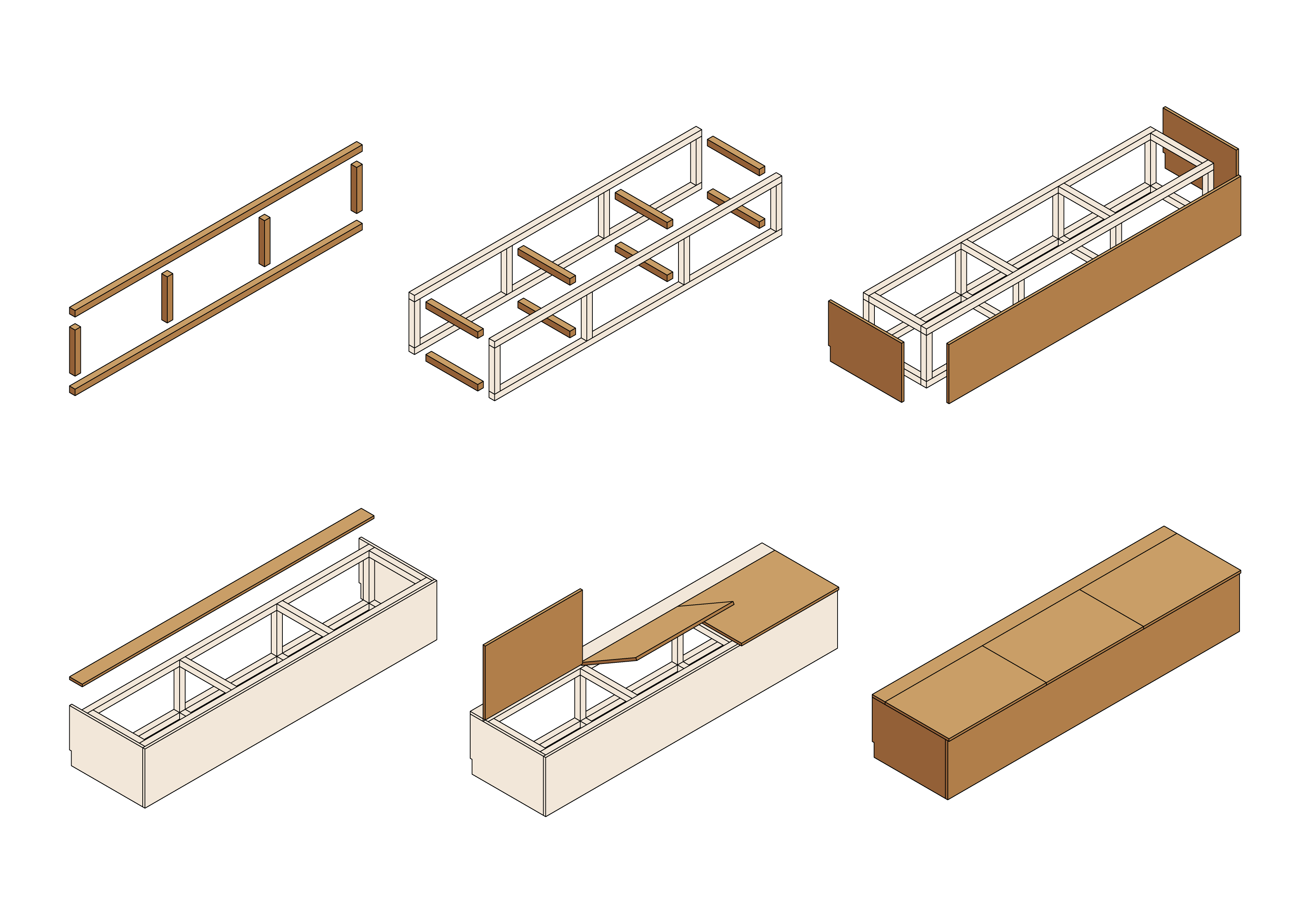
What makes this a quick project is that it requires only a few different parts in only a few different shapes and sizes. All component dimensions are based on standard sizes for each part, resulting in very little left over materials.
Note that standard sizes may differ from the stores here in The Netherlands so be sure to check your local store in order to get the most out of your material.
Most hardware stores around here have a service to saw the wood you buy for free or for a very small fee. This saves you a lot of time cutting all the pieces to size and makes it a lot easier fitting everything in your car ;)
If your store doesn't provide such a service just print out the shopping list and cut all of the pieces to size before we begin assembly in the next step. In case the wood has any rough edges from cutting, use the sand paper to smooth them before continueing.
Frame
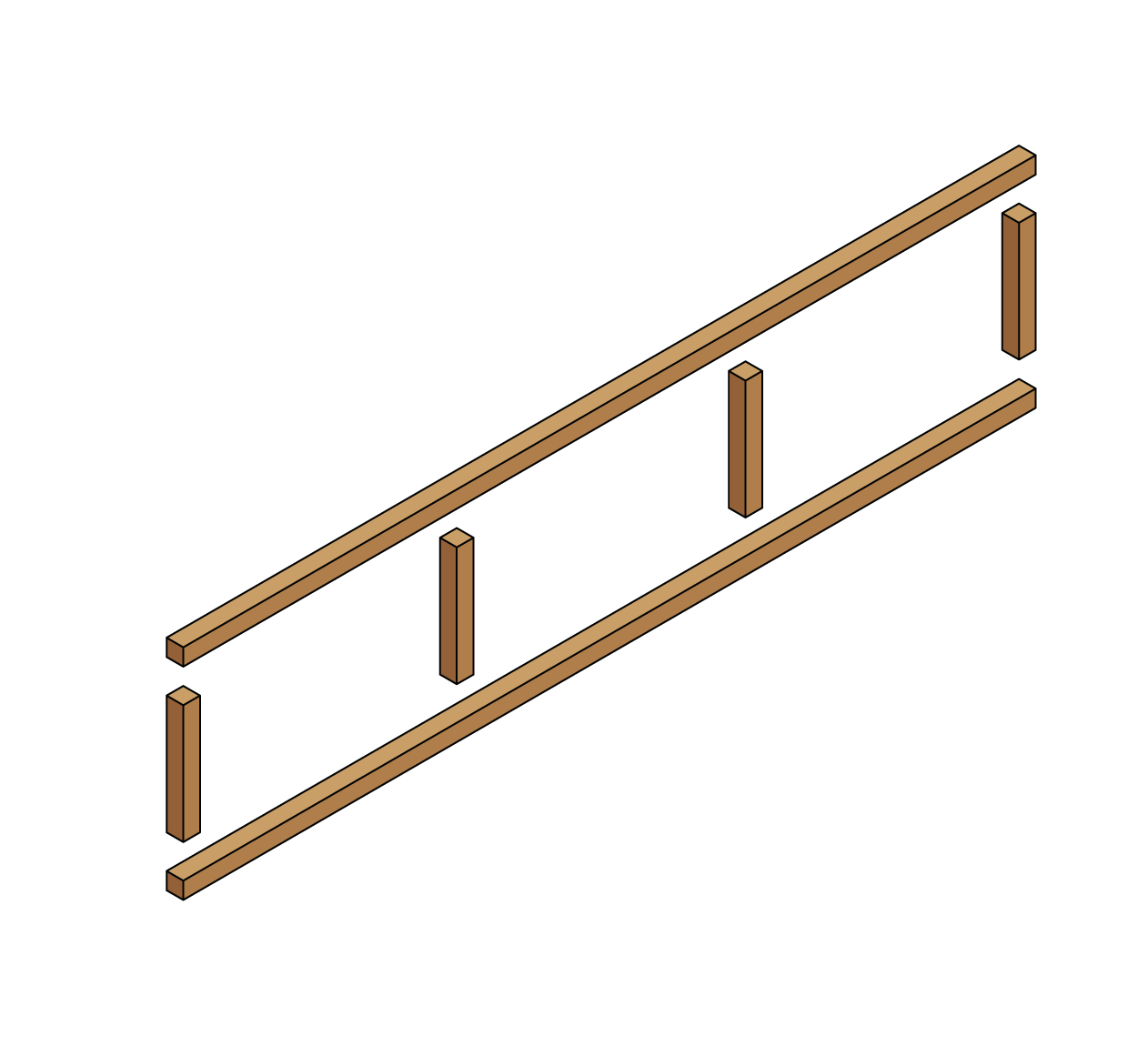
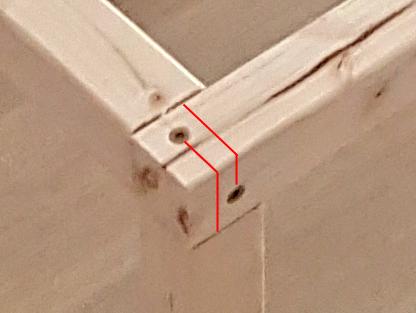
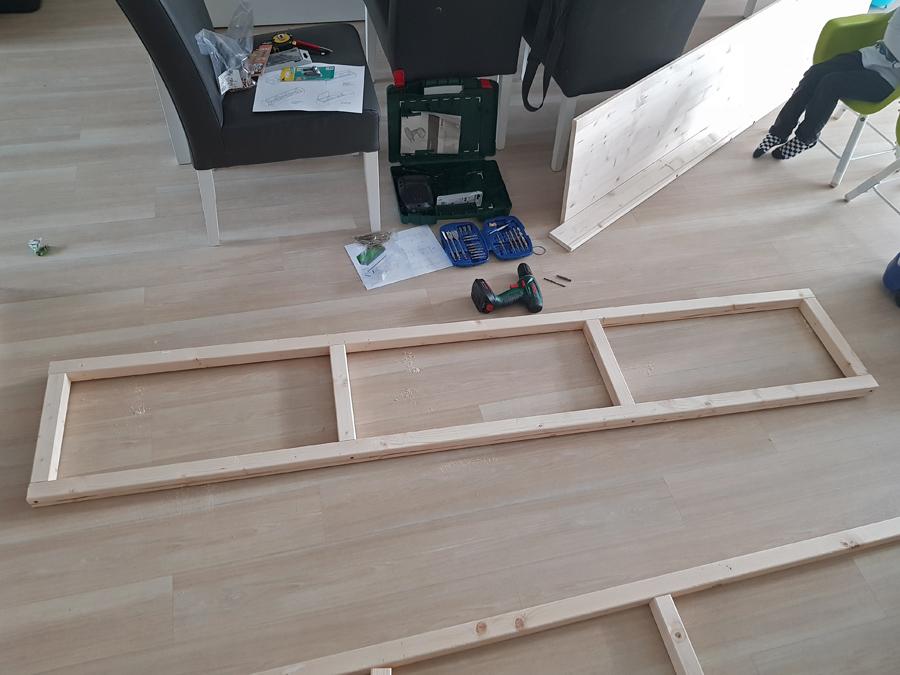
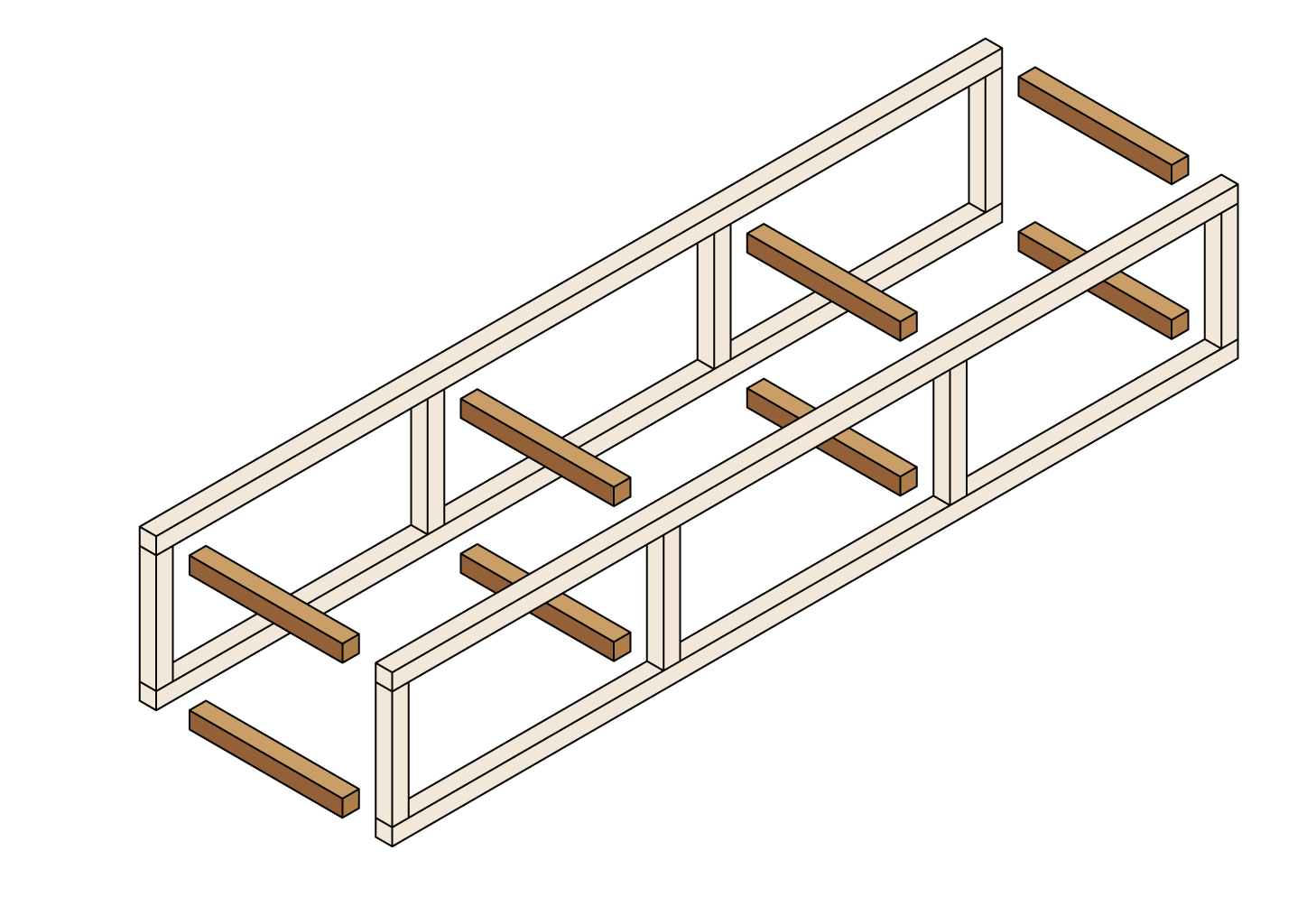
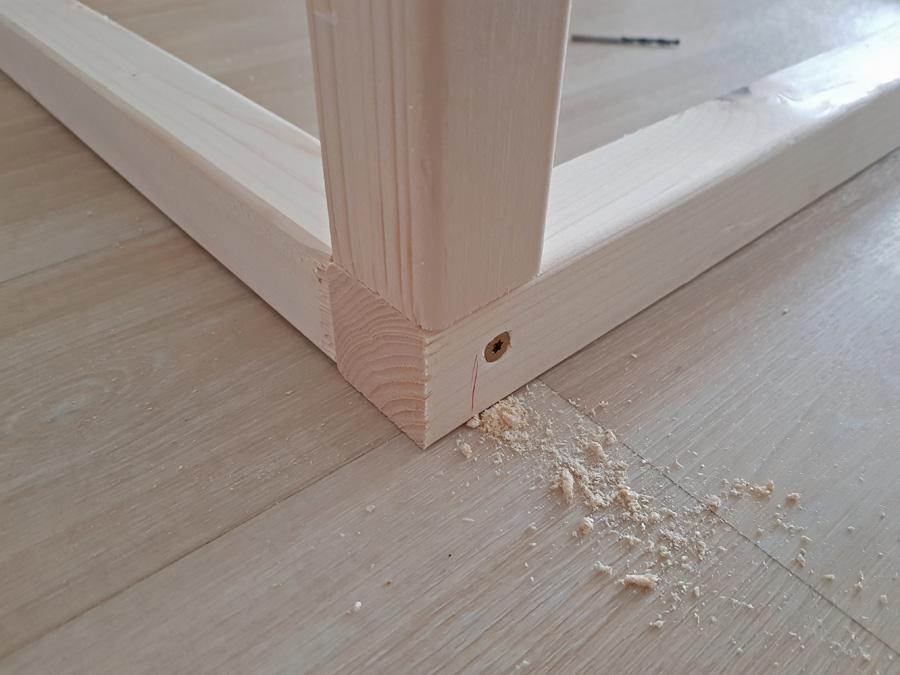
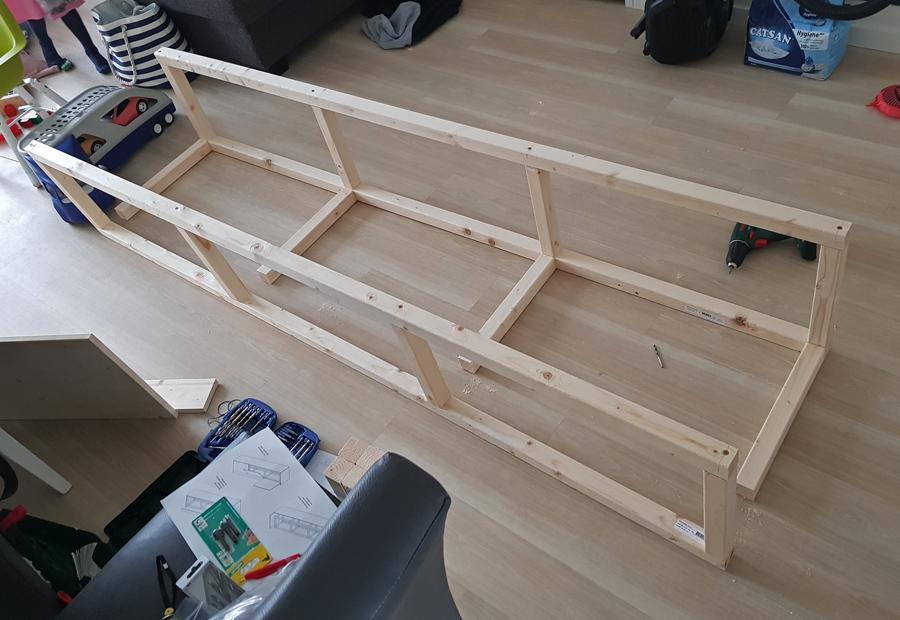
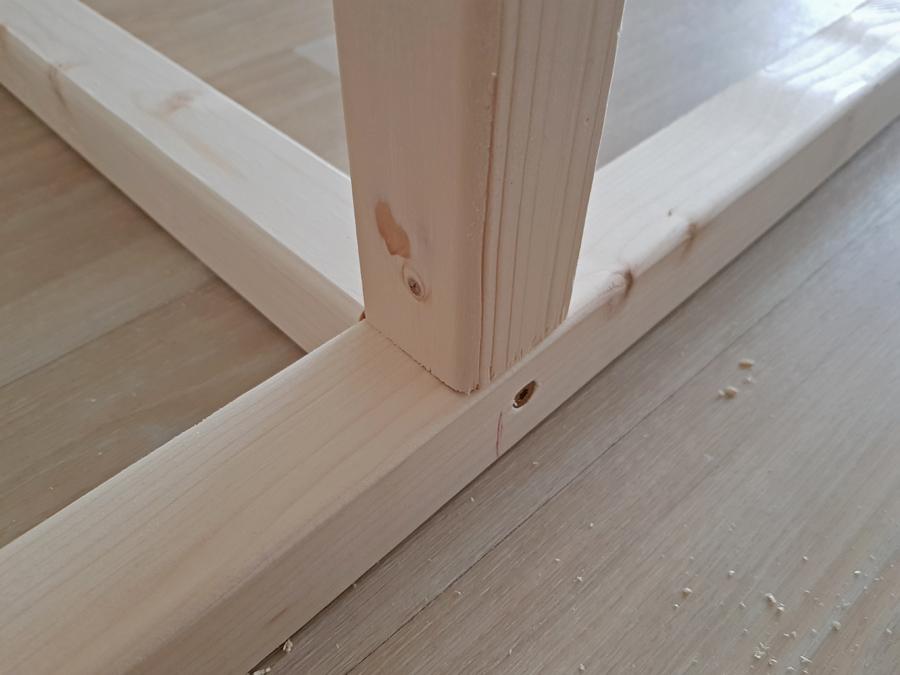
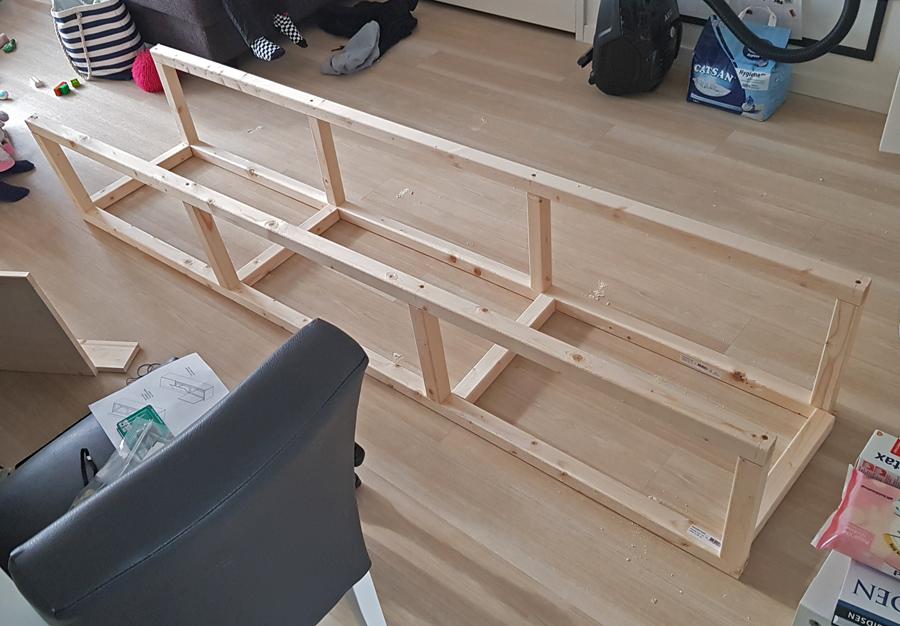
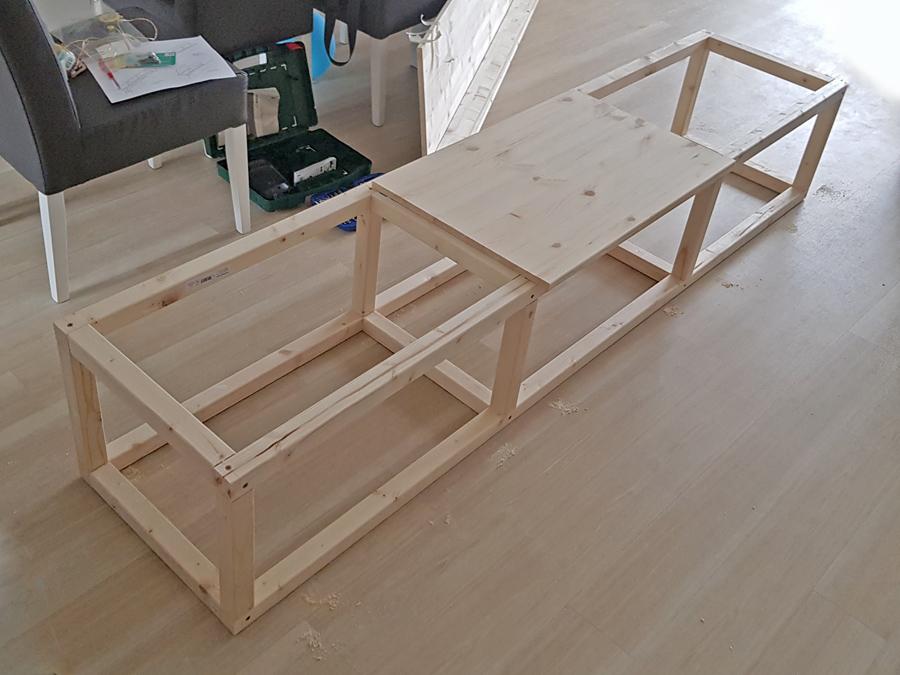
First make sure you have the right components at hand and make 2 sets of the following parts:
- 2 long beams 44x44x2244mm
- 4 short beams 44x44x312mm (the shortest ones)
- 8 wood screws 4x80mm
Line up the parts on the floor and ask a family member or friend to hold the parts in place while you drill the holes.
Get your drill and wood drill bit to drill the holes for the screws so that they don't split the wood.
IMPORTANT: do NOT drill the holes exacty in the middle of each beam, but off to the side a little bit. Otherwise the screws connecting the second part of the frame will cross the first screws and might get stuck halfway into the wood. Keeping the screws about 10mm apart will do the trick. This means drilling the hole about 5mm off center. If you want you can mark the places to drill with a pencil to make sure you start drilling in the right spot.
Drill all 16 holes (8 for each set) and screw in the screws fixing the parts together to make 2 identical frames like in the 3rd image.
Next get the remaining 8 wooden beams (44x44x406mm) and line 4 of them up with the 2 frames. The easiest way to do this is to place the frames upright and put the short beams on the floor in between. Take 8 wood screws (4x80mm) and place them at each connection.
Get your drill and drill the 8 holes for all connections and screw in the screws fixing the parts together. Make sure you do NOT line up these screws with the ones that are already there. Keep them about 10mm apart.
Once the first 4 beams are firmly attached to both frames creating a u-shape you can carefully flip the frame over creating a n-shape. Place the last 4 short beams on the floor at each of the intersections. Repeat the previous action and drill 8 holes and screw in 8 screws in order to attach all parts creating a box-shaped frame like in the last image.
If you like to be extra safe you can add some additional brackets to the frame (see Step 4, image 4).
Front and Side Panels
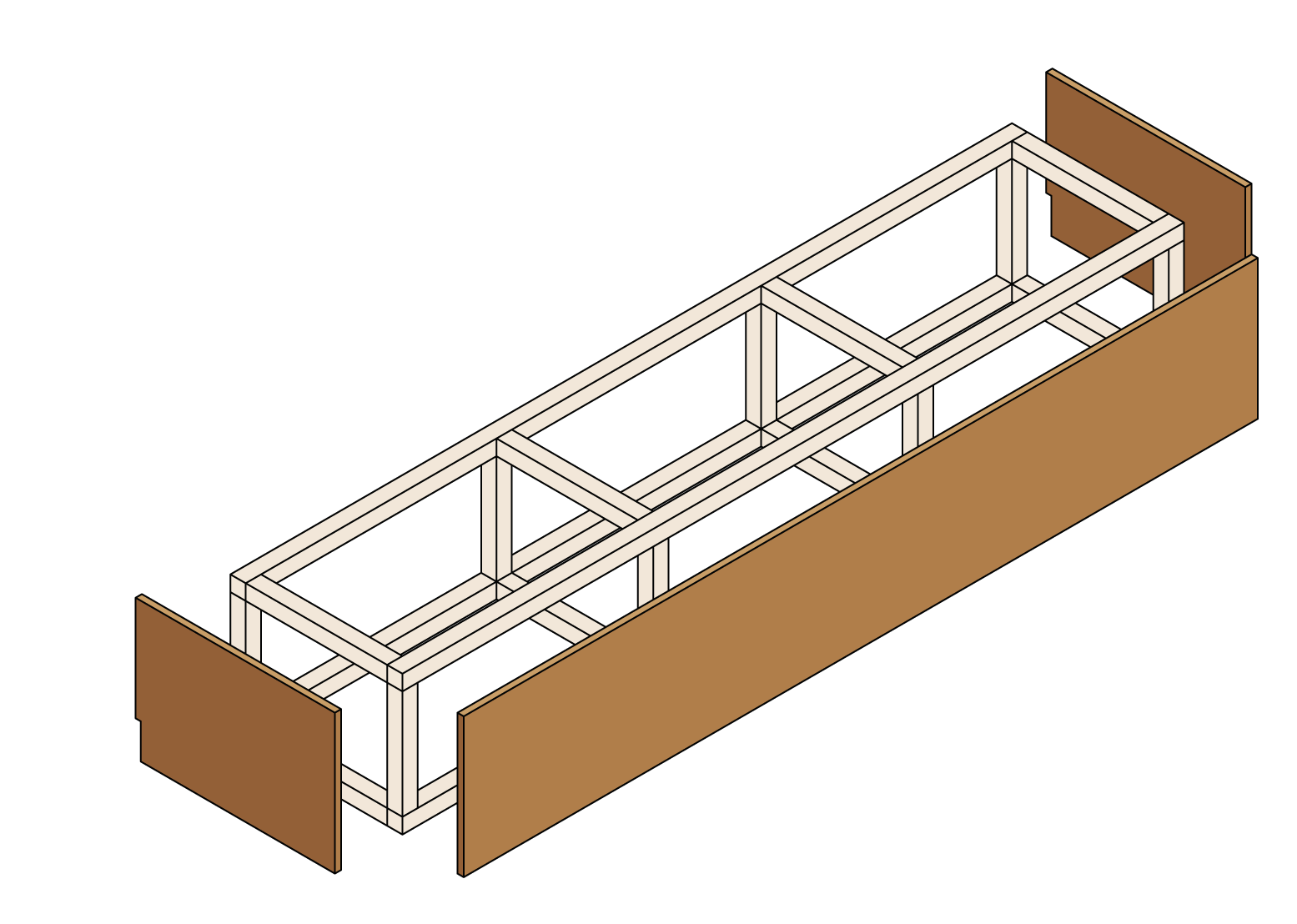
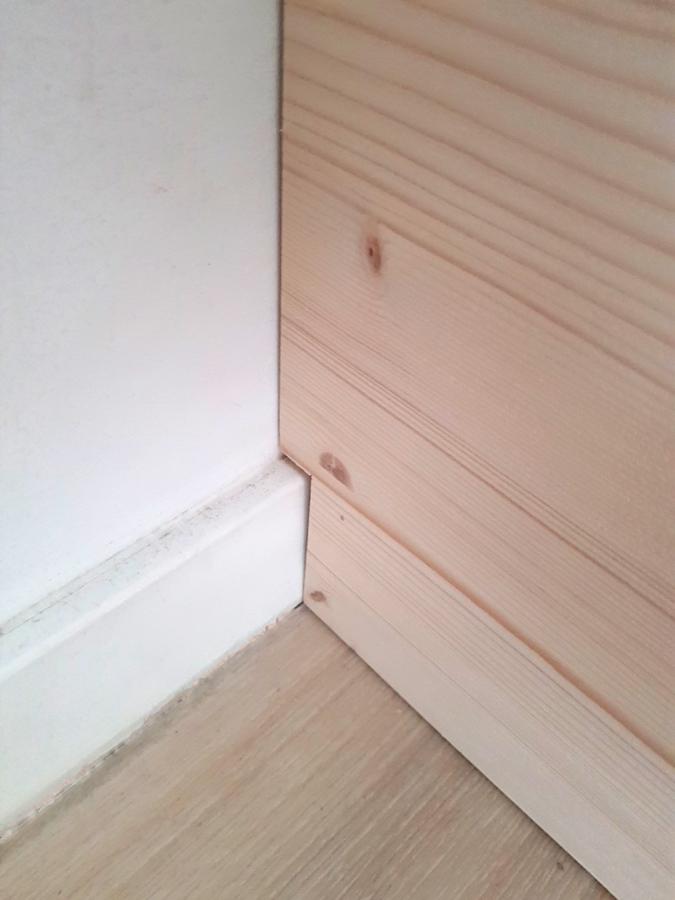
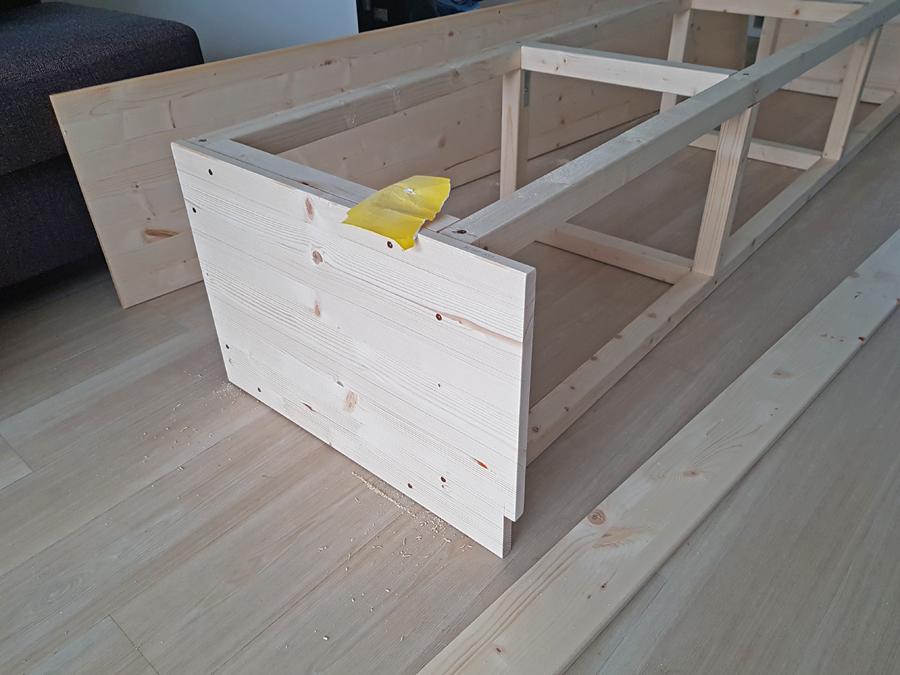
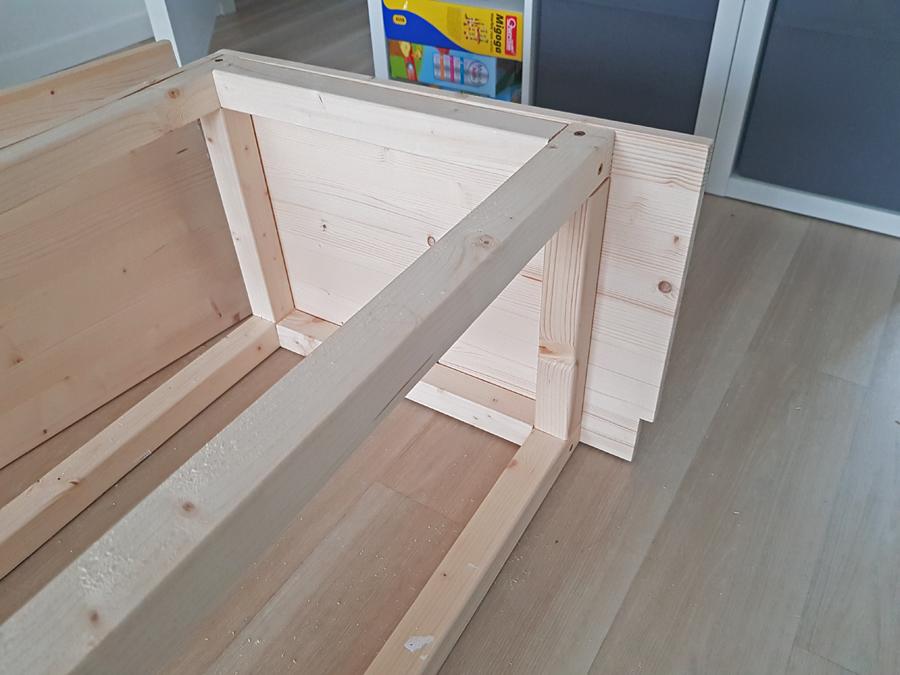
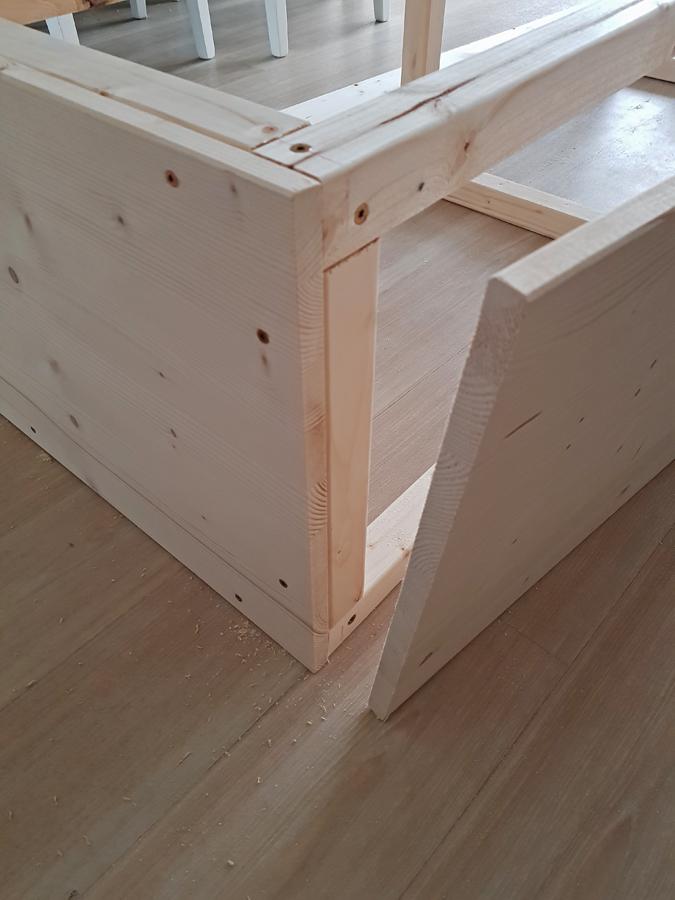

Before moving on to attaching the panels to the frame, make sure the frame is as level as possible. Wooden beams can be twisted slightly which means the box frame you just assembled can be a little bit wobbly at this stage. Do not worry, this will all work itself out in the end!
Turn the frame over a few times and check which side is the most level and steady on the floor. Line up the 2 side panels (572x400x18mm) and front panel (2280x400x18mm) and double check wether they fit the frame like in the last image. The front panel should overlap the side panels and line up exactly.
In case you have skirting (or baseboards or plinths) where you want to place the bench, this is the time to measure them so we can cut a small piece out of the side panels. This way the bench can be placed right up against the wall leaving no gaps in between.
Measure the skirting and mark the dimensions on the corner of each side panel. Before cutting check which side of the panels look best and make sure to cut the correct corner so that side will be visible once it is screwed in place. Use a jigsaw or miter saw to cut the marked piece of the side panels and sand off any rough edges.
For each side panel you'll need at least 8 screws (3,5x40mm) to secure the corners so they don't warp outwards. Since the corners of the box frame already have 2 large screws going through, it is best to place the screws for the side panel off to the sides, like in the 3rd image. If you have enough extra screws you can put in one or more extra screws in between the corner screws.
Tip: use masking tape to temporarily secure the panel to the frame while you drill the holes. This way you can use both hands for drilling without the panel falling over.
Get your drill and drill holes through the panels into the beams of the frame. Try to line up the holes with the center of the beams in order to avoid splitting the beams. Screw in the 8 (or more) screws to attach the side panel to the frame.
When both side panels are fixed take the large front panel and line it up with the frame. Use masking tape to temporarily secure the panel in place and mark the places to drill the holes. You will need at least 2 screws for each corner and 3 for each T-connection in between, which makes 20 screws in total. Again, if you have extra you can place more screws in between. Mark the places to drill similar to the side panels: a little off to the side from each connection to avoid the large screws.
Get your drill and drill holes through the panels into the beams of the frame. Try to line up the holes with the center of the beams in order to avoid splitting the beams. Screw in the 20 (or more) screws to attach the front panel to the frame.
Top Panel
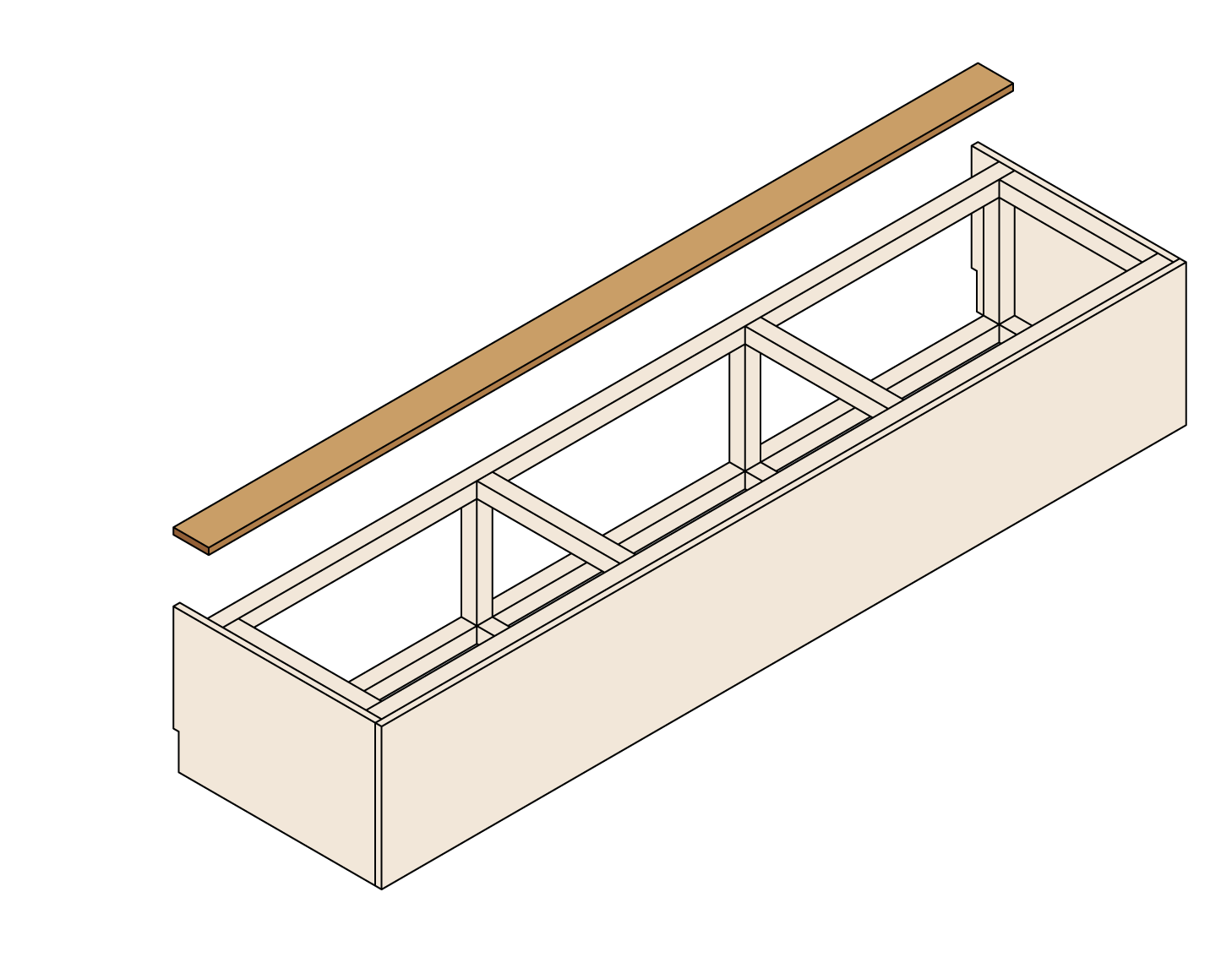
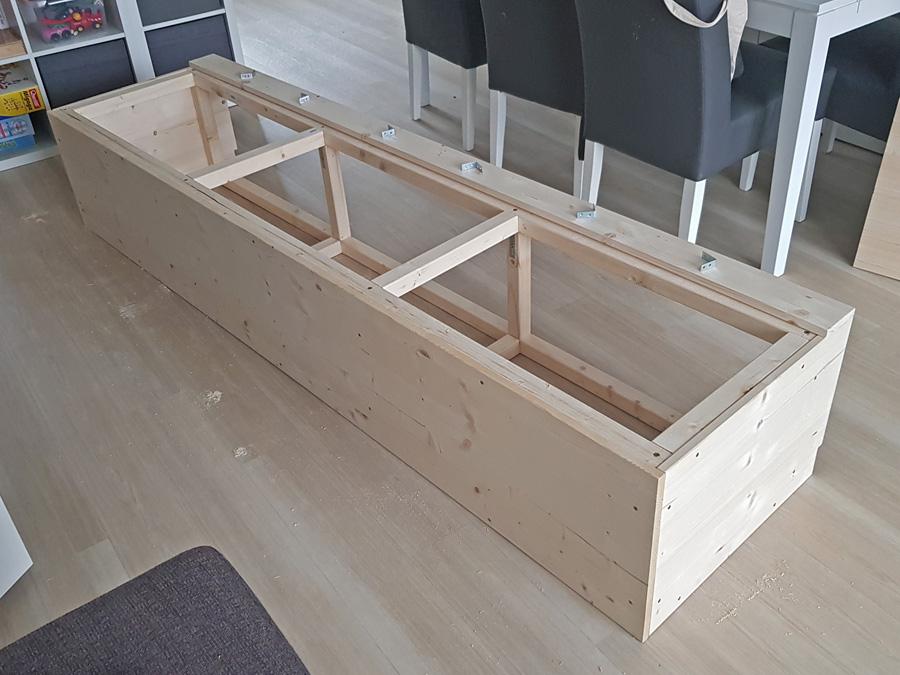
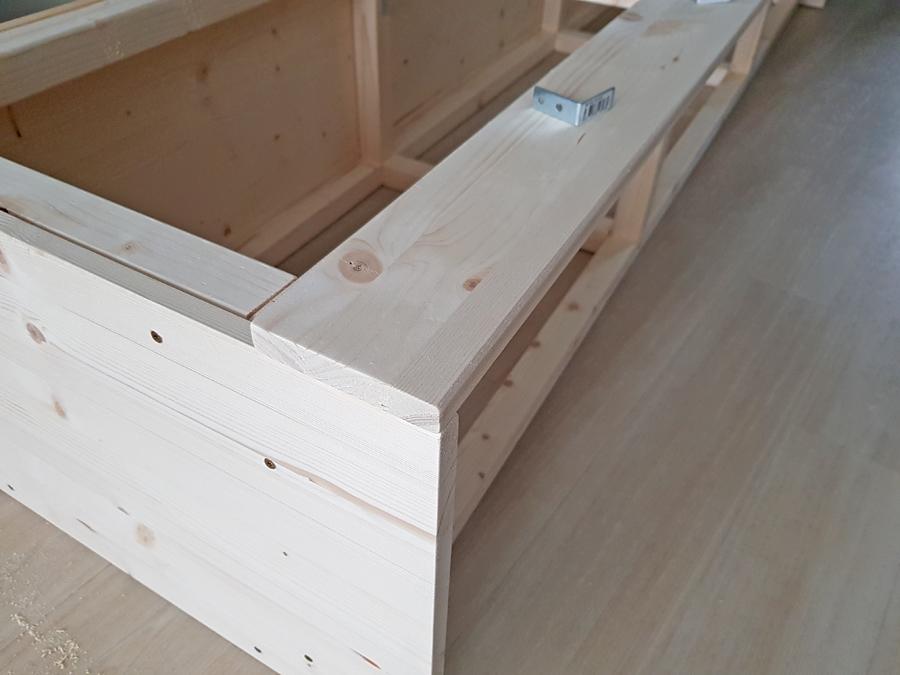
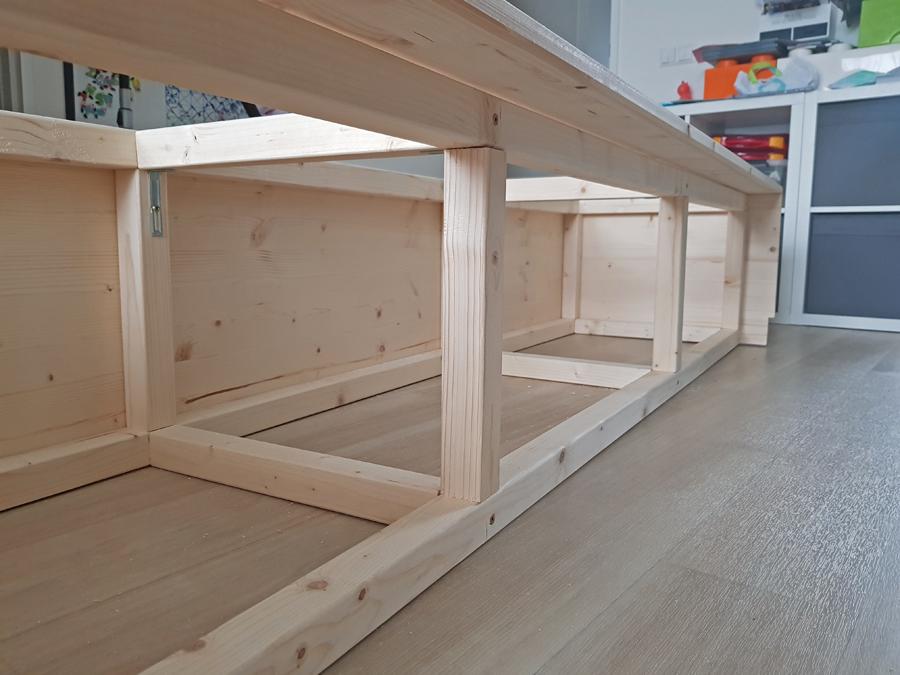
The top panel is there to attach the hinges for the lids to and to allow the lid to be opened up all the way and lean against the wall instead of falling back down while you're searching for crayons.
Since only the edge of the panel is resting on the frame we will fix the panel in place using the corner brackets. They will go underneath the panel, attaching the panel to the long frame beam. Lay out the 6 brackets on top of the panel, in between the frame beams, spacing them apart as evenly as possible. Get 12 of the remaining scres (3,5x20mm) and put 2 next to each bracket.
To make sure the panel is flush with the lids, ask someone to push down a little while you secure the brackets. Hold the bracket in place underneath the panel and pre-drill the holes in both the beam and the panel through the holes in the bracket. Make sure you do not drill to deep and go through the panel. There will probably be 2 or 3 holes on each side of the bracket, but you only need to drill 1 hole on each side. There won't be much weight on the back of the bench and with 6 brackets the panel will not go anywhere.
Get the 2 screws and screw them in, fixing the bracket in place. Repeat this another 5 times and the top panel is done!
Painting (optional)
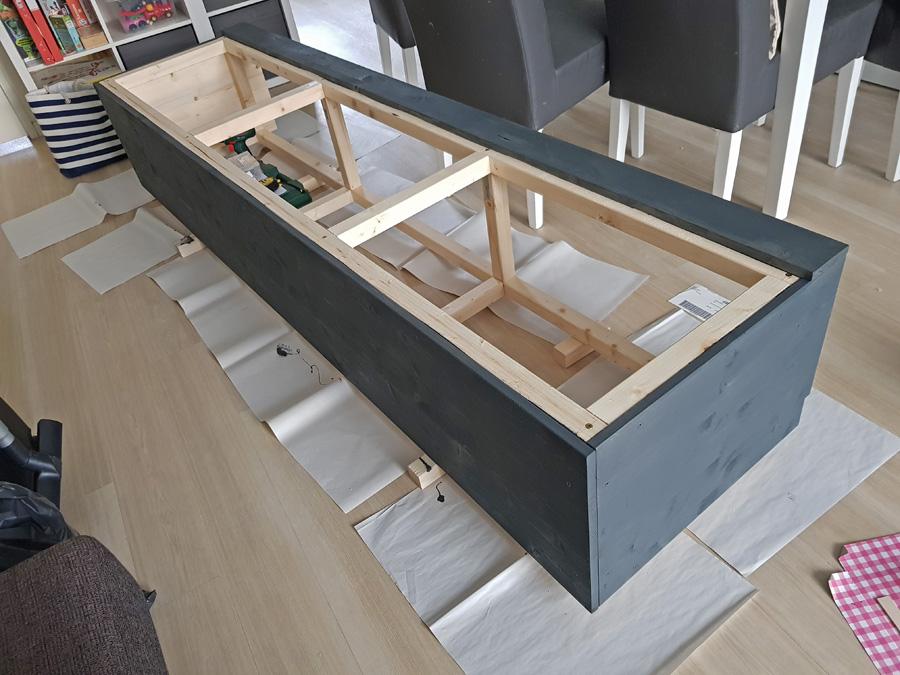
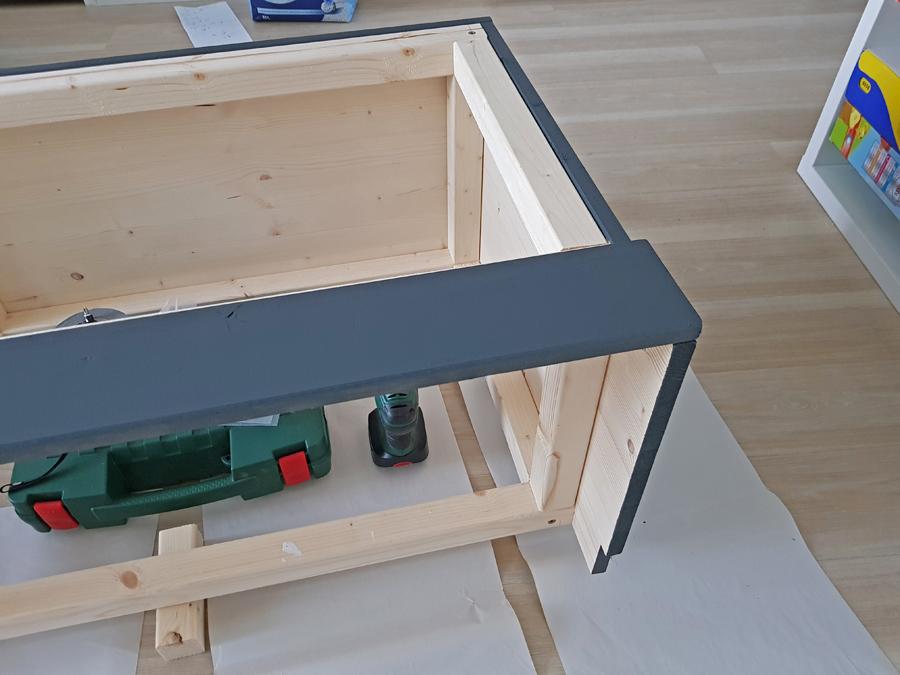
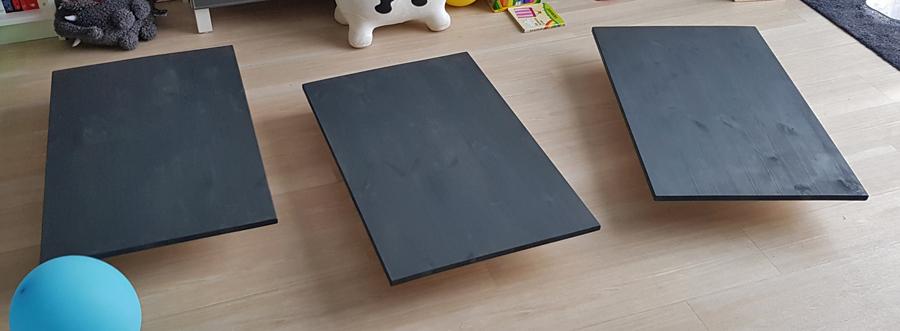
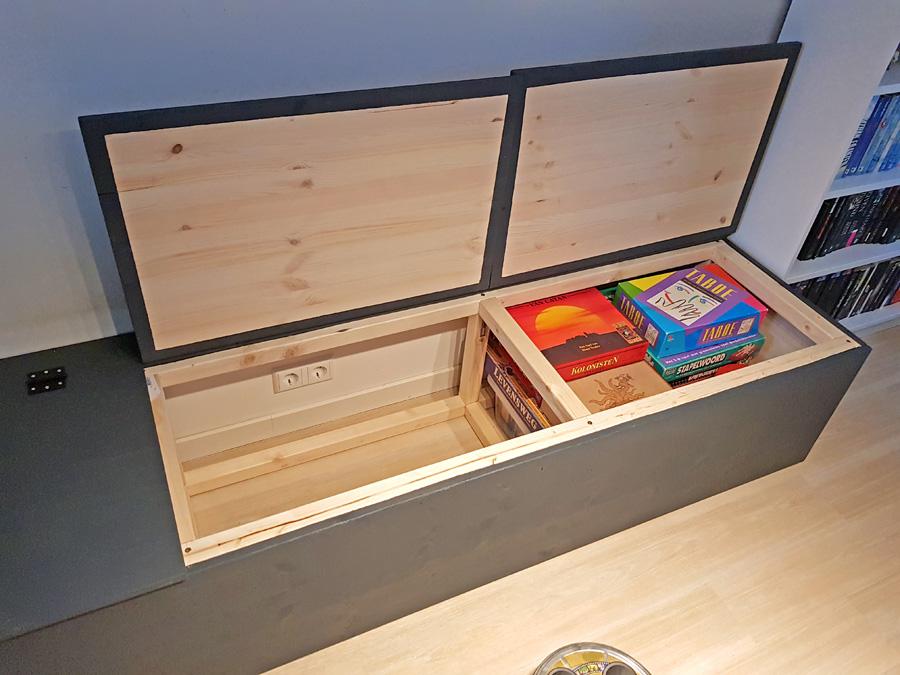
If you want to add some paint or other finish to your bench, this is the time to do it. When the hinges are attached painting the lids will be a lot more difficult.
You can choose to fill the screw 'holes' with filler or putty to create a smooth finish. Note that sometimes these areas can become more visible when painted because they are smoother than the wood around it.
I chose to paint the outside of the bench a matte dark grey and left the rest of the wood inside its natural colour. To avoid leaving gaps in the paint visible on the outside I also painted the edges of the panels as well as a border on the underside of the lid panels. This way you get a clean finish without having to be very careful with the paintbrush.
Get your masking tape and mask all the bits you do not want to paint. For the underside of the lids I taped a rectangle about an inch from the edge to create a straight line.
Prop up the bench with some sticks so you can paint the edges on the bottom and to avoid the paint sticking to the paper/sheet. You can place the lid panels on some books and paint the top side. When it is dry turn it over and paint the border on the bottom side.
Depending on the desired finish you can sand the panels and add additional layers of paint. Make sure all the parts are dry before assembing the lids.
Lid Panels
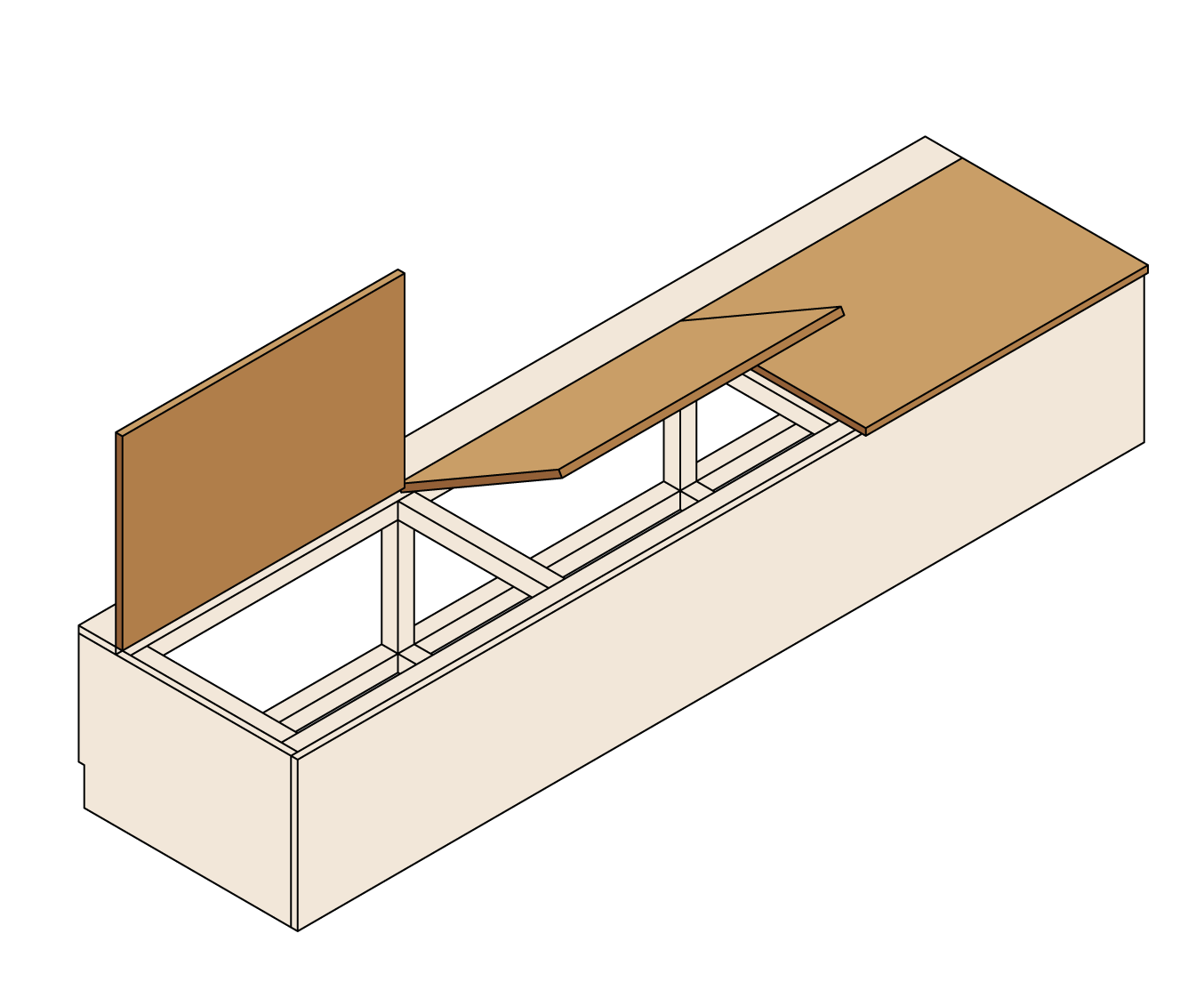
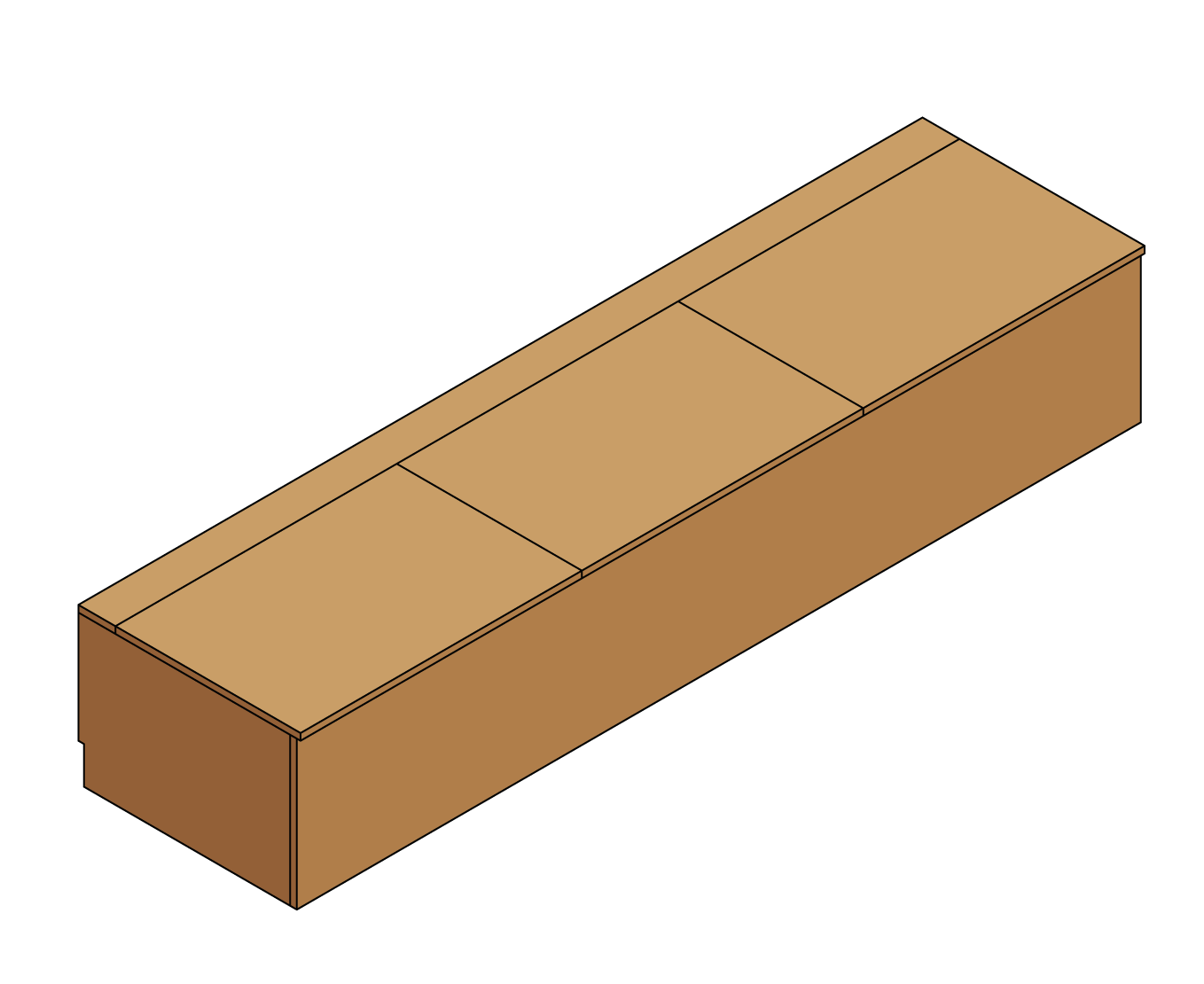
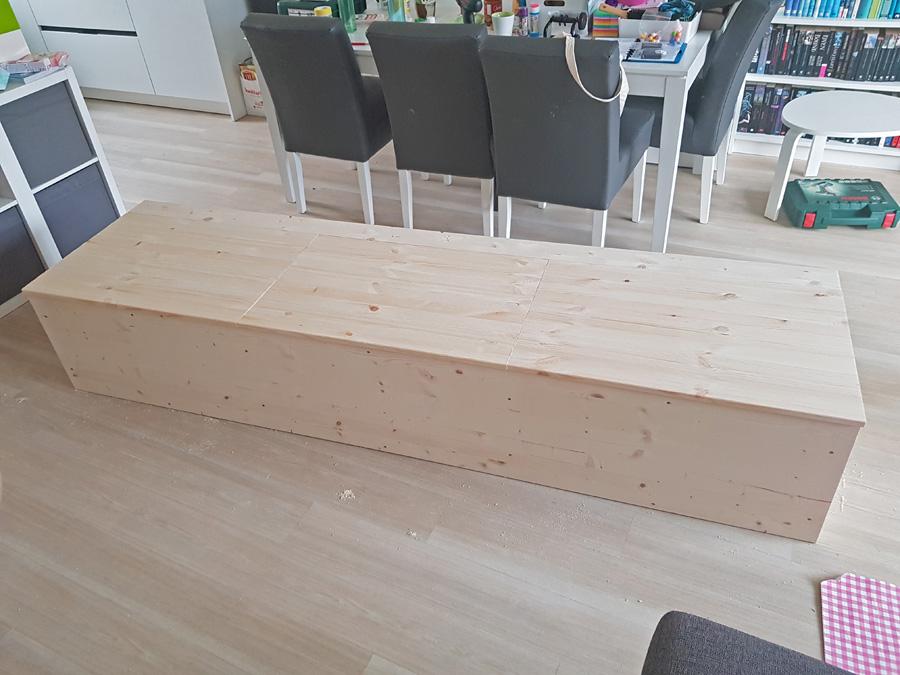
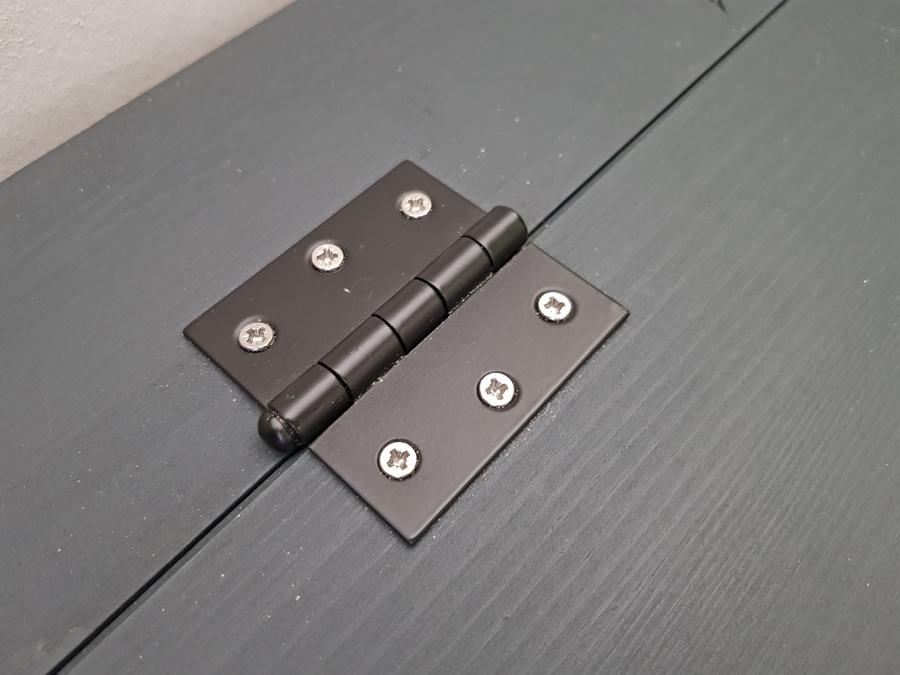
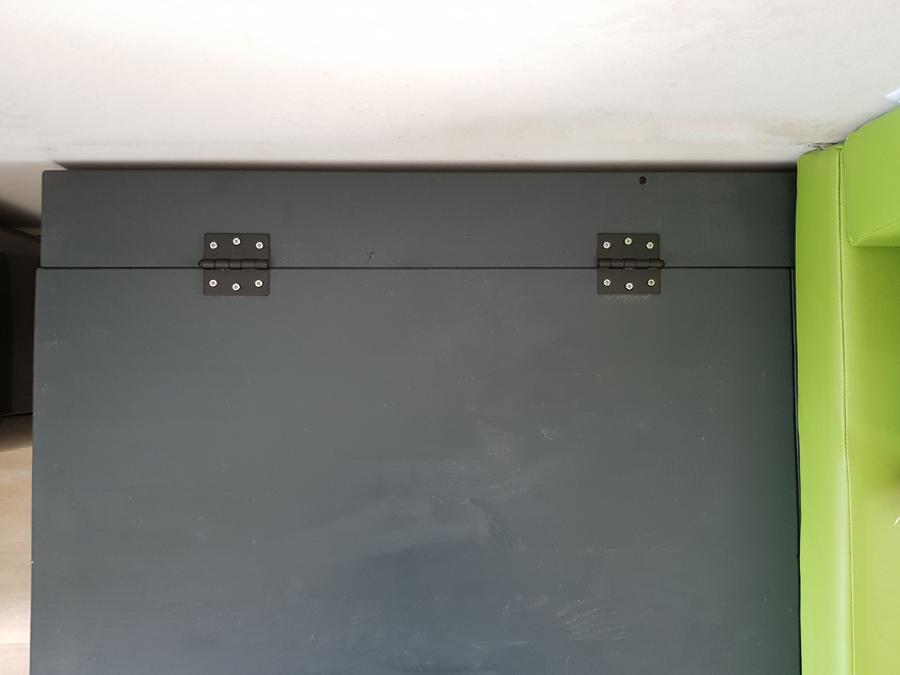
The lid panels will be attached to the top panel using 2 hinges for each lid. I chose black hinges to match the bench and these hinges hapened to have 6 holes for screws. If you use hinges with 4 screws you will need 12 screws less.
Put down the lid panels on top of the frame and make sure they line up on all sides. I put pieces of 0,5mm cardboard in between the lid panels to make sure they would not scrape against each other once they were fixed.
Get your 6 hinges and 36 screws (3,5x20mm) and make 3 sets of 2 hinges and 12 screws. Lay out the hinges on top of the lids, on the edge between the lid and the top panel. Make sure the hinges are not in the same place as the brackets holding up the top panel in order to avoid crossing screws.
Hold the hinge in place and gently pre-drill the holes, making sure not to go in too deep. If you use thinner screws or are confident the wood will not split, you can also screw in the screws without pre-drilling the holes.
Repeat this another 5 times to secure the hinges to the top and lid panels. Test the hinges by opening and closing the lids to make sure everything works smoothly.
Enjoy Your Bench!
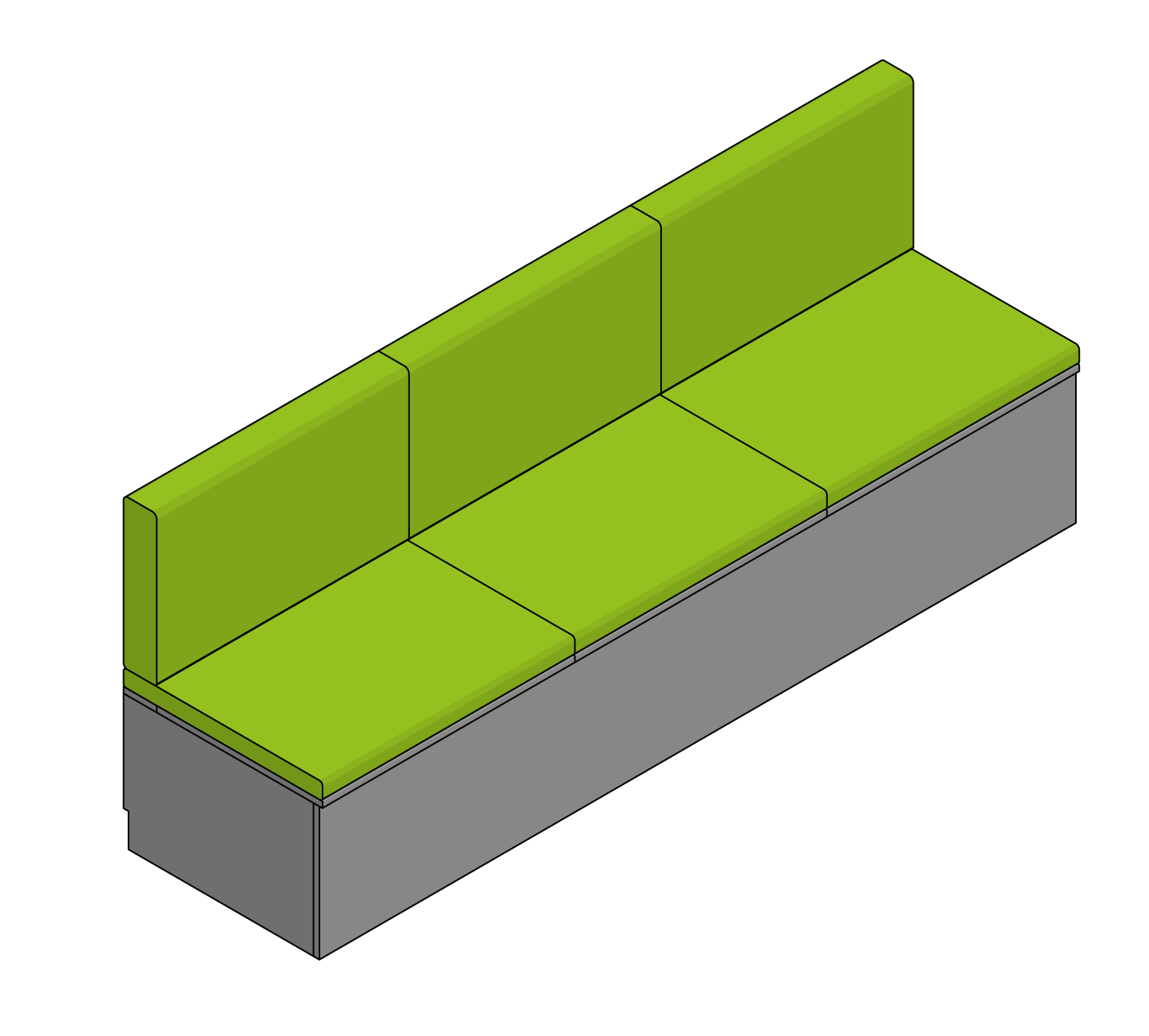
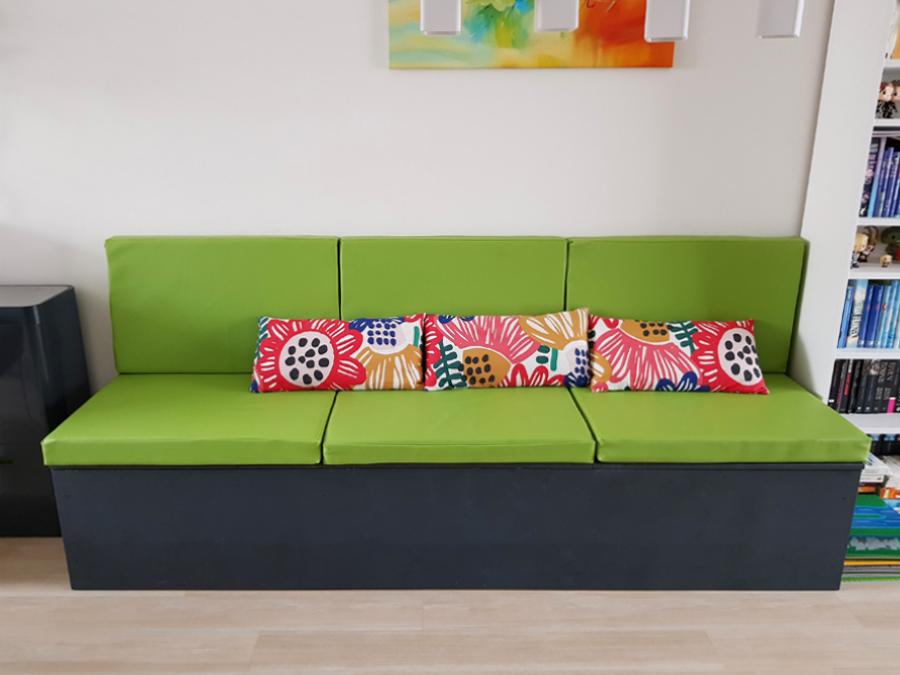
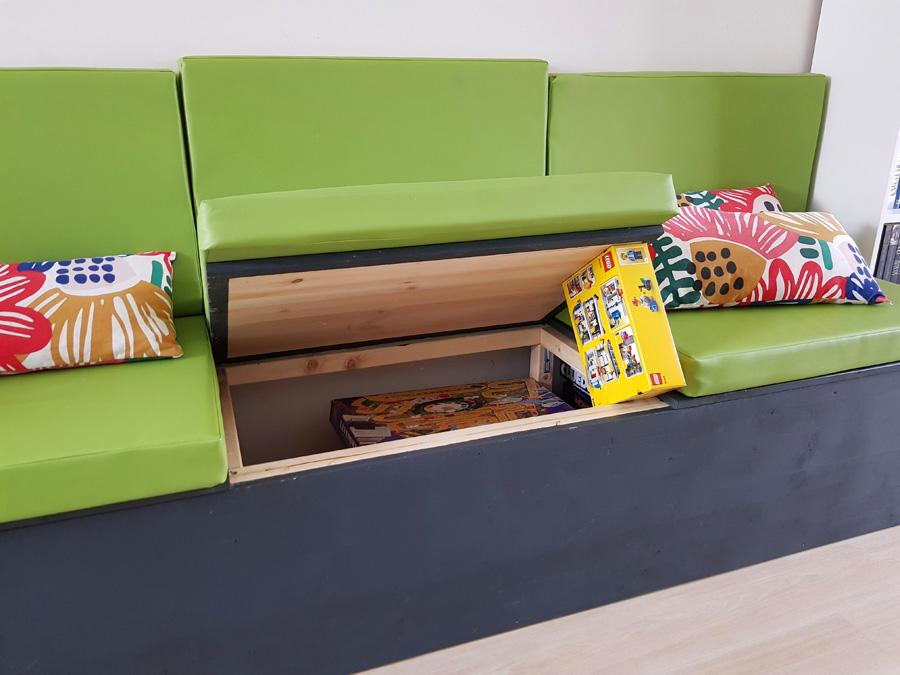
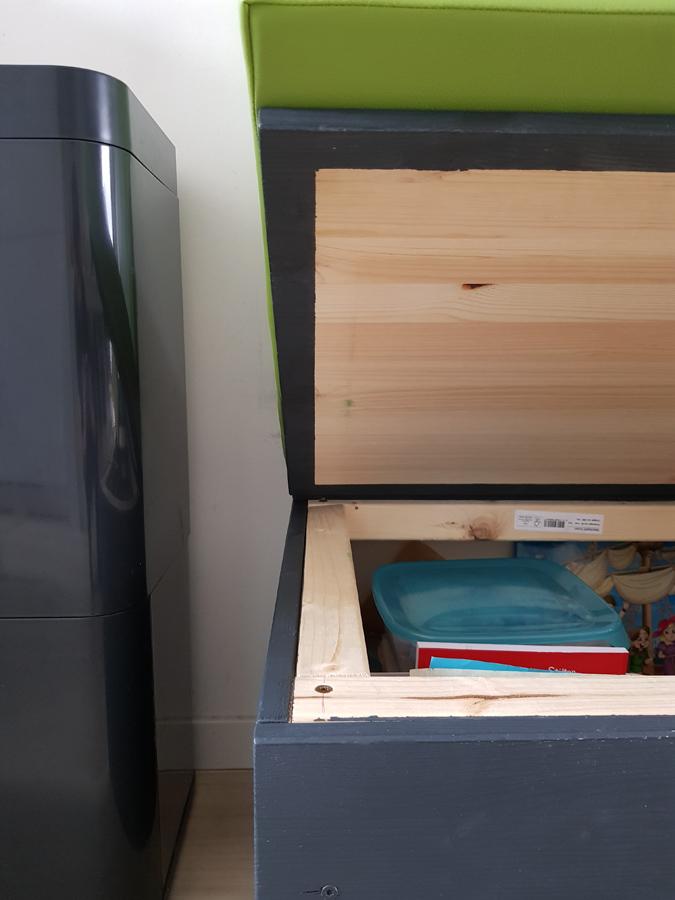
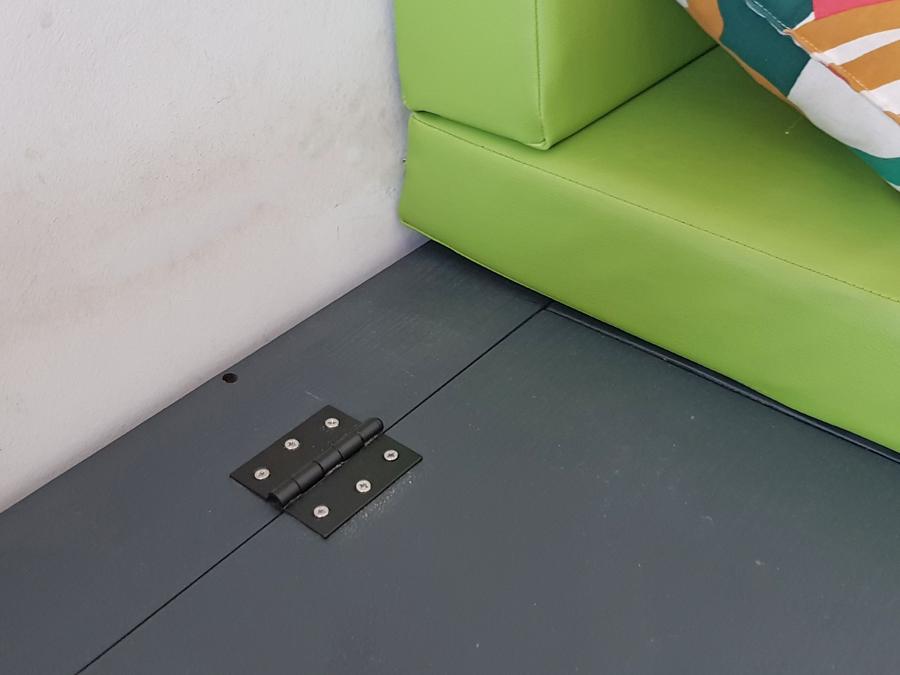
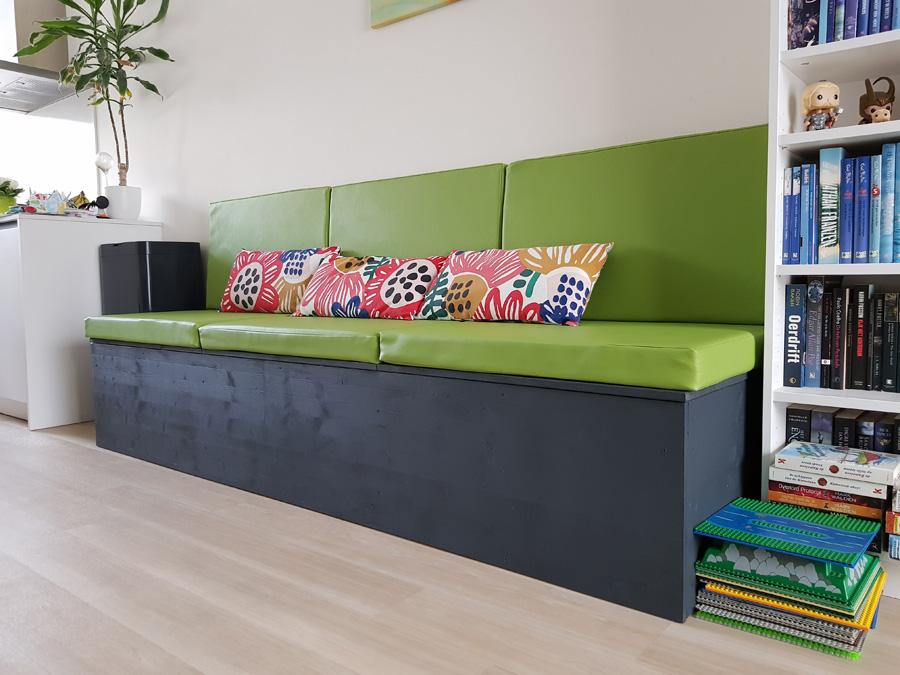
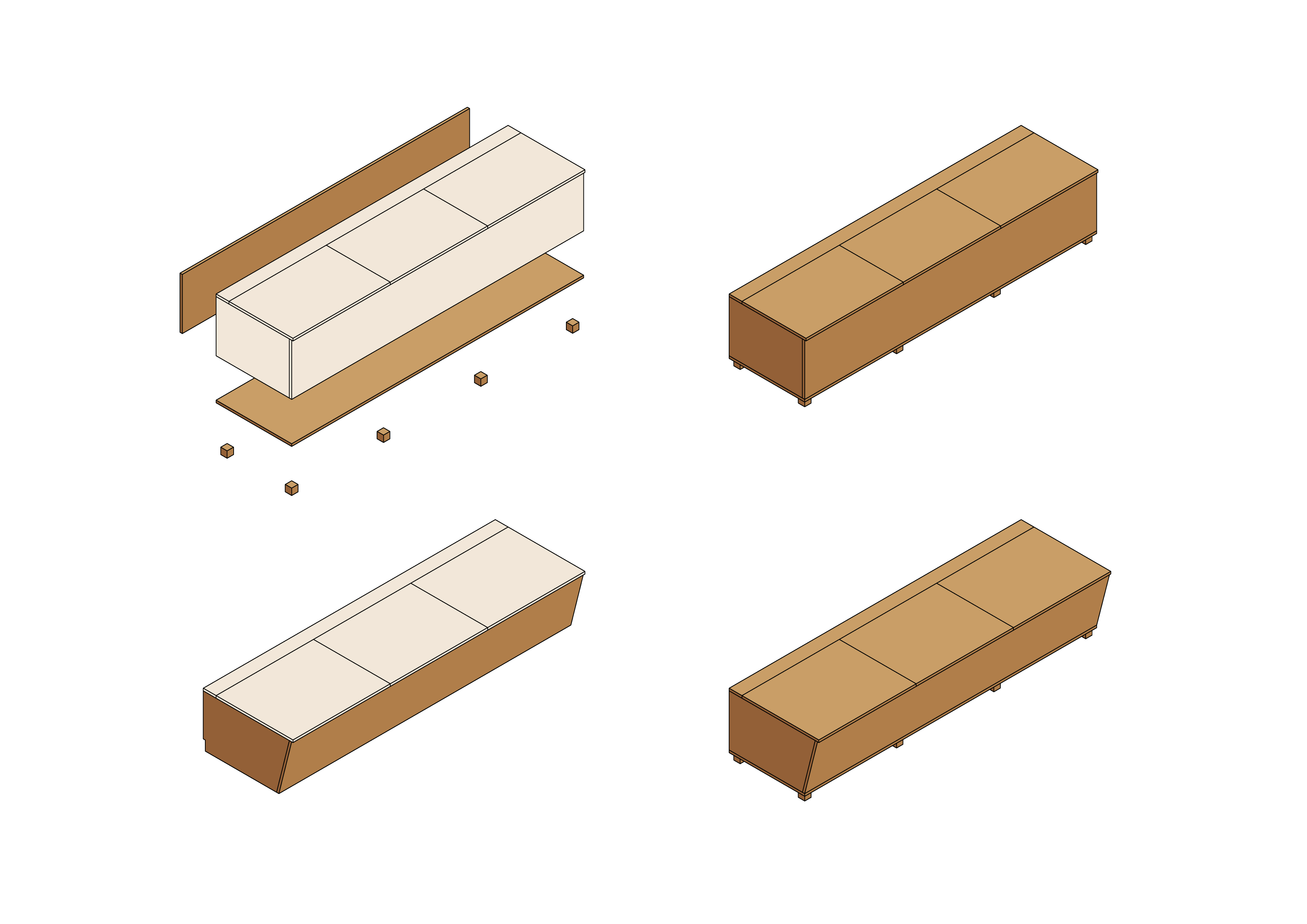
That is it, your bench is finished! Sit down, relax and enjoy your hard work.
You can choose to add dividers between the compartments if you dont want your stuff to slide over to the next compartment. I left the frame open and haven't had any problems with it.
I had some cushions custom made to fit the dimensions of the lids and add a splash of colour. You can also make these yourself of course.
I also put some felt pads underneath the frame to prevent scratching the floor. This also makes it easier to slide the bench in place and move it around if necessary.
I hope you enjoyed this build and I would love to see your results! If you have any questions do not hesitate to ask them in the comments.
Update: optional upgrades
As mentioned by Leon Ward you can choose to add a back and bottom panel as well as some feet to raise it off the floor and place the bench anywhere you like. My advice would be to make the feet high enough to be able to vacuum underneath the bench.
As mentioned by ChrisWX it is also possible to make the front panel at an angle to give more room for your legs and feet while sitting on the bench. You can do this in combination with the box frame and just make the top about 4 inches or 100mm deeper than the bottom.